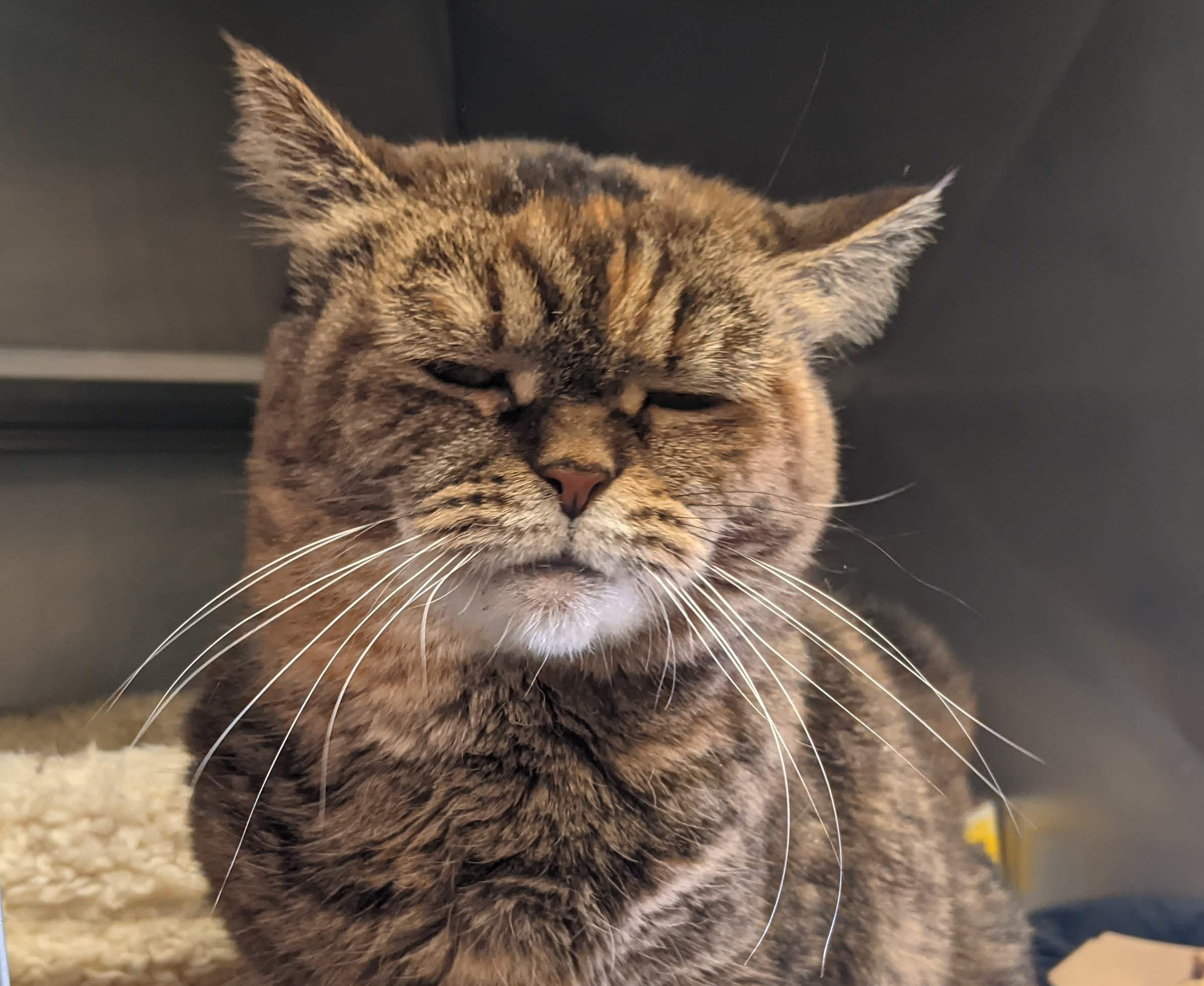
Feline Obesity: The Curse of the Chonk
OOh, chonky cats. Cute, but sad. We can’t help but “Aww” when we first see those chubby little faces, but many of us are a little nauseated and heartbroken along with those coos. The truth is, chonky isn’t cute;it’s morbid…and this is another one that is almost completely in the hands of human behavior. Do we know we’re doing it? Most of the time, I’d say not, but studies are showing that our mentalities surrounding cats, our relationships and activities with them, obesity, and food itself play a big part in how our cats fare. If your cat is over 13 pounds and not a large breed such as a Maine Coon or Savannah…we have a problem. It’s agreed upon by most veterinarians that the typical male cat should not exceed 11lbs, the typical female cat not over 8lbs. I don’t typically see that much of a musculoskeletal size deviation in male and female cats, so this might be a bit much sometimes, but I don’t think it’s terribly off. In my own cats, I have found that at 9.5# they seem to all, male and female, have near-perfect BCS (Body condition score), one needing a little bit more as he’s tall and lanky, and one needing a little bit less as she’s a bit more petite. My most recent veterinarian told me as a blanket statement that any non-large breed cat should not exceed 10lbs regardless of sex when I expressed concerns that one of my boys was looking a bit “lumpy” at 10 – and I think that’s pretty accurate overall, with some individual factors to be taken into account. Ultimately, look at their body condition. You want to see muscle tone, you want to see the dip from rib cage to hip. You want definition. If they’re just a blob, they’re not healthy. Let’s talk a bit about why “chonk” is so bad, why I care so much, what it can do to their health and behavior, and how to prevent it…
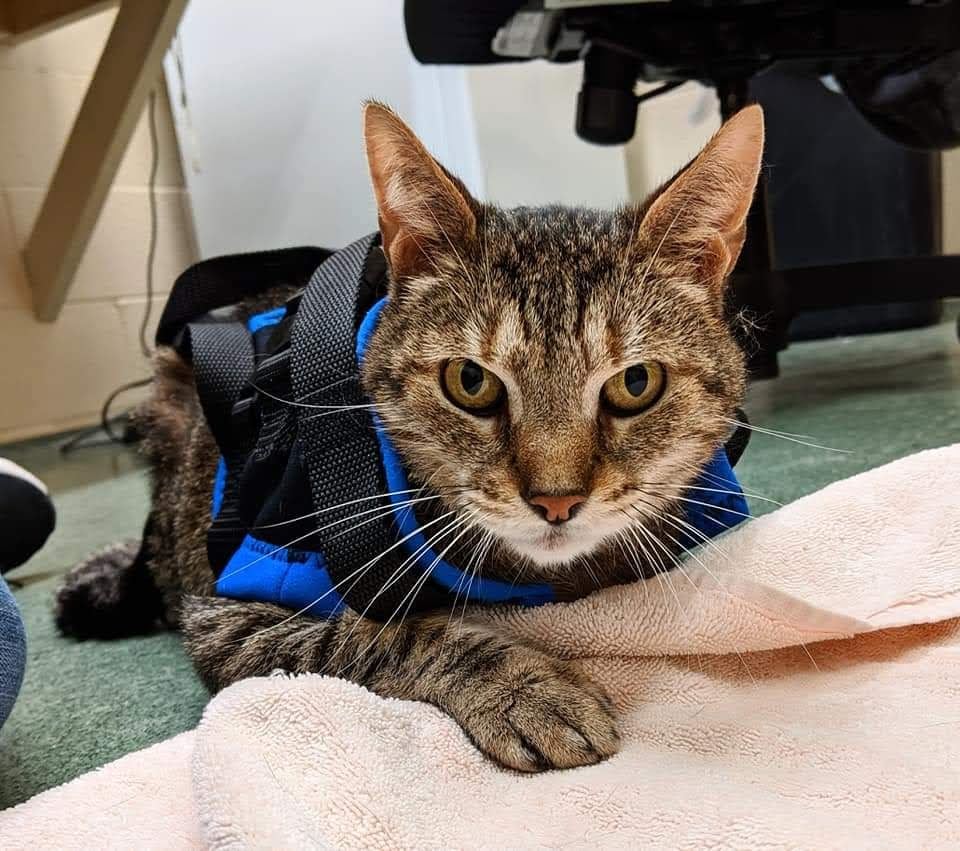
Rambo, an obese diabetic tripod I helped through recovery
Two years ago we had a three-legged cat at the shelter, over 20lbs and diabetic. Since he was in a kennel, we thought his immobility was due to fear for quite some time, until finally we realized he couldn’t walk. His weight had taken such a toll his legs couldn’t bear it anymore. He was suffering, and to boot, his best friend was adopted without him shortly after they arrived. His stress skyrocketed. He became my special project. I was determined to get this boy mobile. I ordered a special harness to take weight off of his little legs. We put him on scheduled feedings and the appropriate insulin doses, he got daily out-of-kennel sessions walking on his harness, freeze-dried turkey enticing him to travel from place to place until he didn’t have the strength left. He went from scared and cowering to rolling and bunting. He went from unable to even stand to walking several feet before toppling without his harness. He lost two pounds. He no longer needed insulin. He was adopted by a wonderful woman who had tripod experience and was just as passionate about his case as I was. I want every obesity case to be taken so seriously. All of this was achieved in just over a month, in shelter shift-work. Had he been a foster cat, he may have come even further. If he could achieve insulin stabilization, two pounds of weight loss, and muscle growth to that extent in just over a month, just think of what can be achieved! Think of the life these cats can get back if we apply ourselves. I see so often the easy way being taken – the vet prescribes a limited dry diet, 1/4 cup of (x) dry food twice a day. In the shelter I often see that the cats don’t even like these diets – often just electing not to eat which is dangerous, potentially signing up for hepatic lipidosis. (Liver disease) When they do like it, they lose weight at a snail’s pace, if they do at all, and guardians lose hope. Maybe they don’t follow the diet as strictly as they should over time as the cats start begging, stealing bread, chip bags, pasta, and generally getting into mischief. (I’ve gotten these calls…and isn’t it interesting what they’re targeting, why not chicken, lunch meat, meat packaging? We’ll discuss that!) Their cats are lazy and, more than likely a bit painful or potentially in some respiratory distress – they don’t want to play, and often these guardians aren’t given alternative tips to get them moving, so they just don’t. And these cats stagnate. I had a bit of an argument with a client at one point about her obese cat, she was very concerned with his weight and desperately wanted to get him moving but he wouldn’t. I told her we needed to use food to get him to move and she about lost it! The concept of feeding him even low-calorie treats was an insult to her. I was trying to hurt her cat, he was on a strict diet! She couldn’t come to terms with the fact that it was getting him to burn calories, these would be carb-free treats – even just pure meat. We could subtract those calories from his diet. There are so many workarounds. She refused. And that was that. Regardless of my successes, the trauma had been created, and even though she was stuck, food was the problem and the veterinary advice she’d gotten, even if it hadn’t worked to this point, was what she was sticking with. Almost every study I’ve read on this topic acknowledges it as “The” most important issue affecting cats at this time, or “One of the” – so why aren’t we attacking it head-on, why aren’t we creating massive treatment plans? Why do we just throw dry food at it? Human convenience. As usual. But we’re not the most important factor here, we’re the ones causing the problem. You’ll rarely find a fat feral cat, even after TNR.
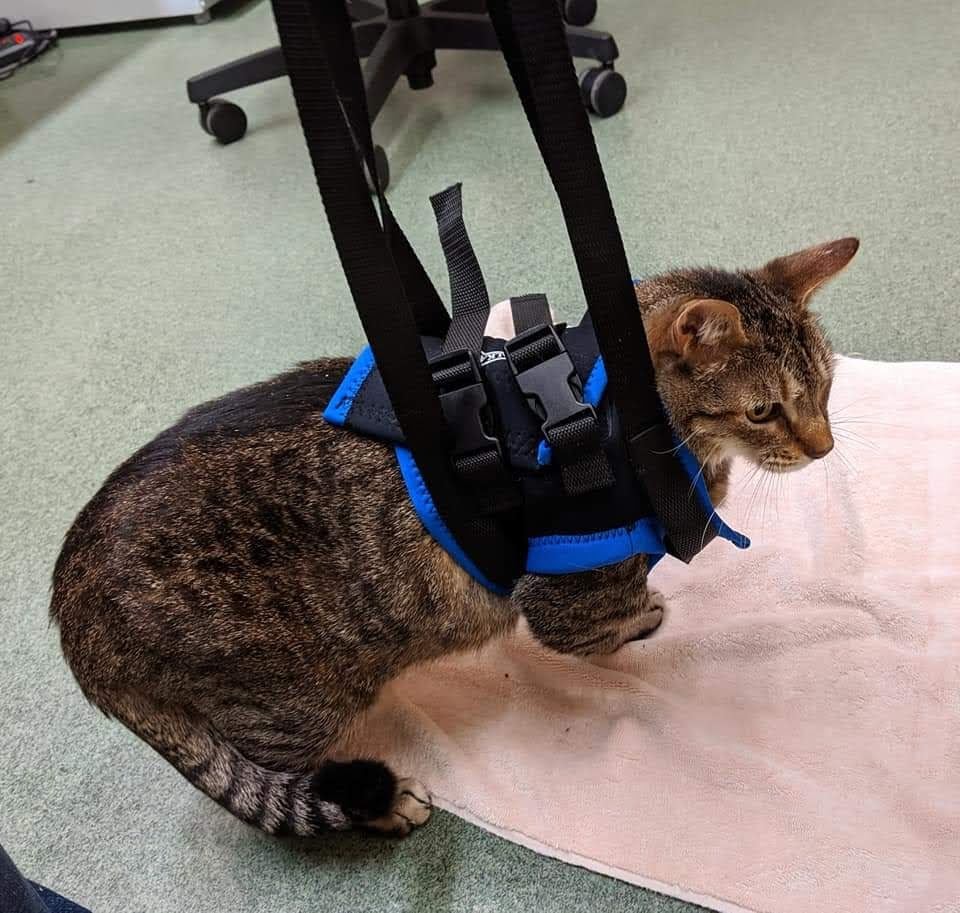
Rambo in his fancy harness
Let me note. There are other factors to feline obesity. It’s not all just “You messed up!” There can be genetic factors, there are medical conditions and hormonal imbalances. Genetics will not make a 20lb cat, however (Unless it’s a Maine coon and 20lbs is literally what it’s supposed to be, of course.) and medical or hormonal issues should be looked into, not just left to fester. Spay and neuter do play a part in weight gain, cats are generally more trim when unaltered but again, an altered cat does not just suddenly become a 20lber due to that alone. I have a house full of trim cats who were all altered between 8 weeks and 4 months of age; it’s not an excuse, it just means their hormone regulation isn’t keeping them trim on its own. So even with all of these factors that very well do alter weight, your animal’s weight is still your responsibility; it’s their health.
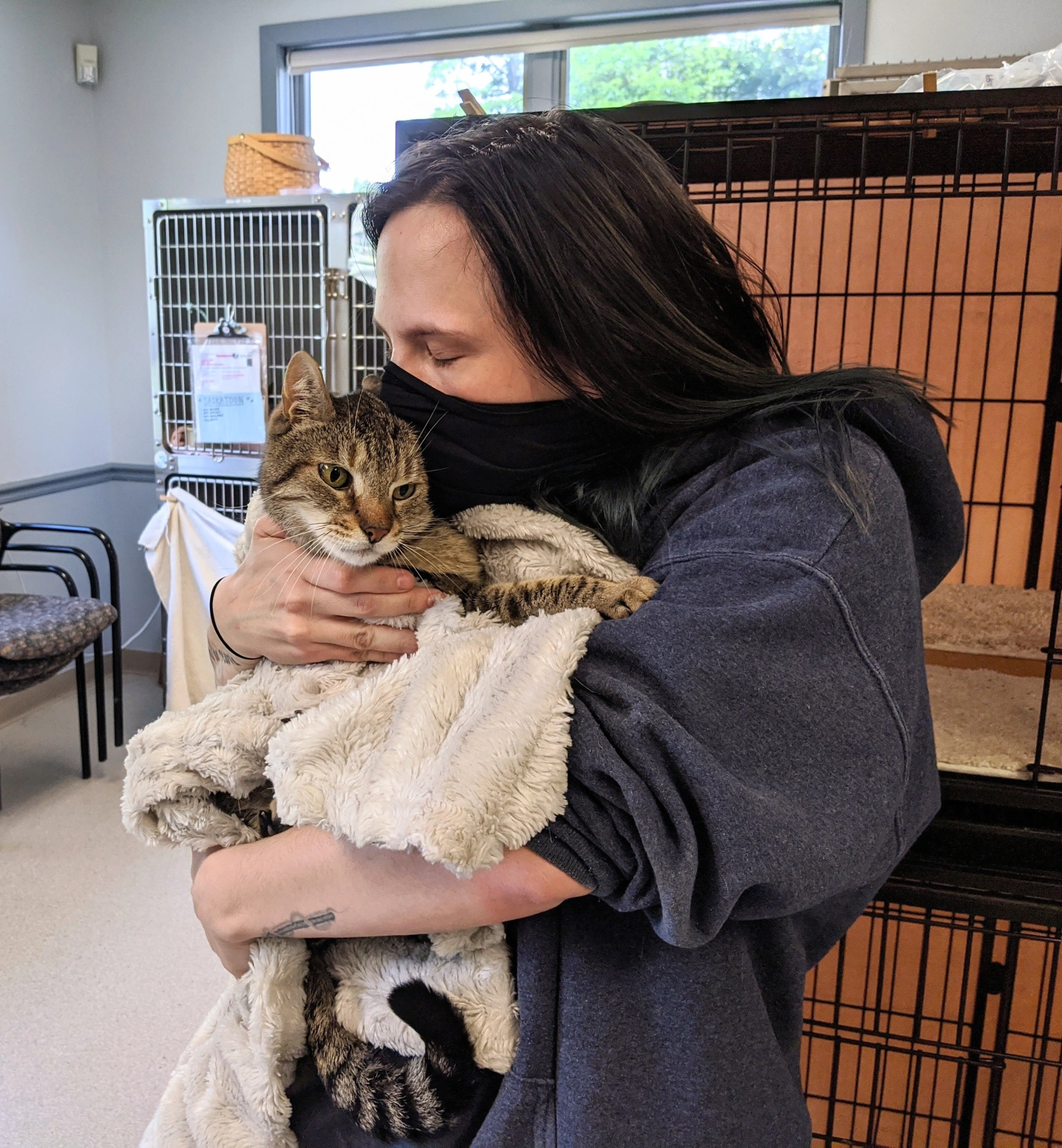
Saying goodbye to Rambo on his gotcha day!
So, to start, how does obesity affect a cat?
- 1. More prone to diabetes.
- 2. More prone to non-allergic skin disease.
- 3. Cannot effectively groom themselves and develop mats and dull coat, even in short-haired cats.
- 4. Are more prone to lower urinary tract diseases.
- 5. Are susceptible to hepatic lipidosis (fatty liver disease)
- 6. GI issues as IBD/S, chronic diarrhea, constipation, bacterial insufficiencies.
- 7. Neoplasia (Abnormal cell or tissue growth)
- 8. Osteoarthritis and degenerative joint disease.
- 9. Can increase the occurrence of dysplasia in cats predisposed. (Many pure breeds; highly recognized in Himalayans, Persians, Maine Coons)
- 10. Prone to respiratory compromise.
- 11. At greater risk during surgical procedures, have difficulties with anesthetic.
- 12. Increased risk of high blood pressure.
- 13. May be lethargic, lame.
- 14. Decreases immune function, heightened susceptibility to infection and illness.
- 15. Increased risk for certain cancers.
- 16. May miss or avoid the litter box due to joint pain or inability to effectively posture due to size.
- 17. May experience aggression due to joint pain or overstimulation due to lack of activity.
- 18. May develop heightened stress, low confidence, generalized anxiety disorders. These cats are unable to perform like cats and their confidence plummets. Veterinarians suspect they may be at heightened risk of depression. They are often bullied by other animals in the home, often very reliant on one person in the home, and in a shelter environment they may shut down and never recover, their health too poor to cope with the excess stress.
It's just not worth it.
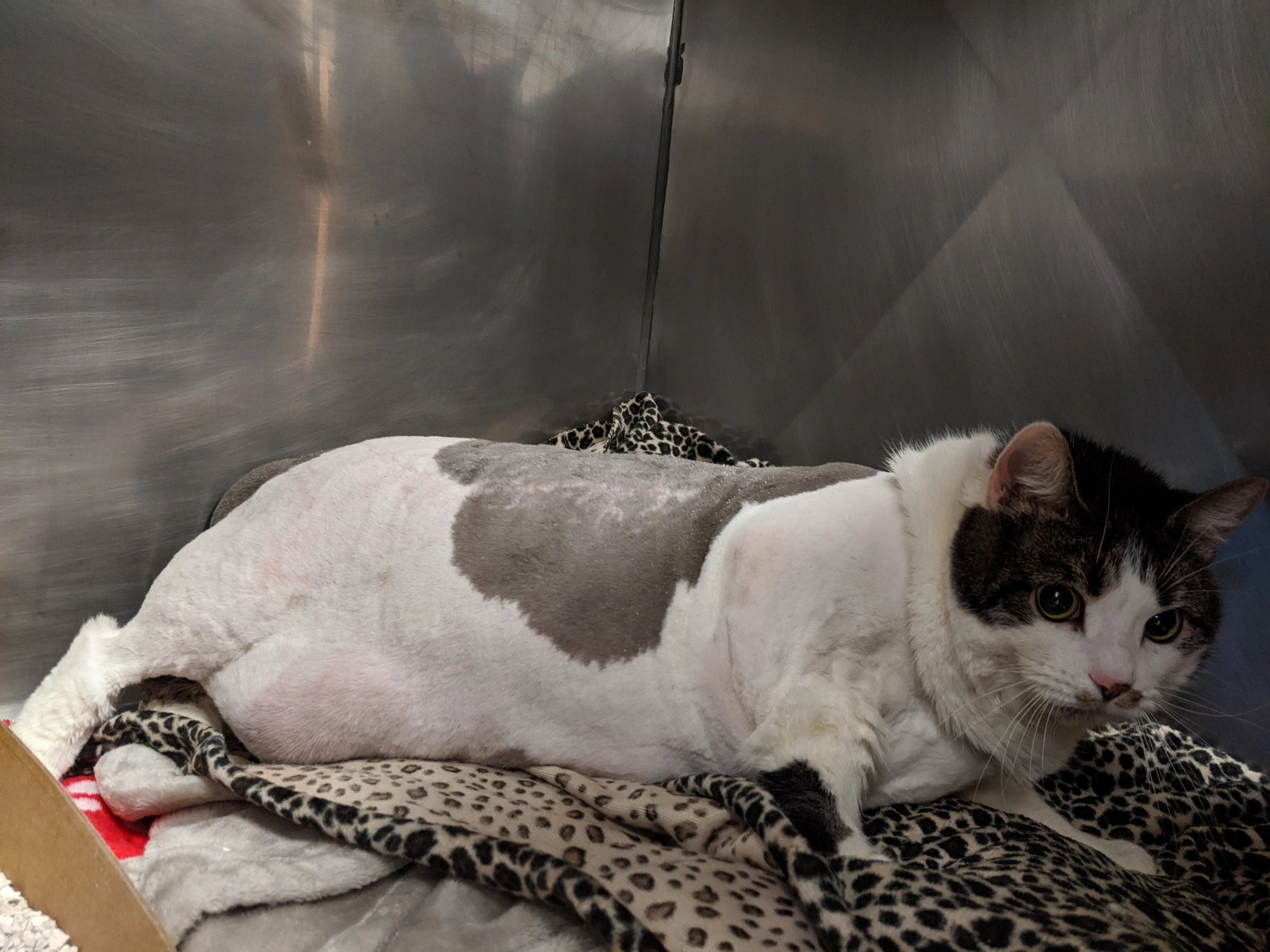
A morbidly obese cat that had to be shaved due to severe matting and skin irritation.
So, how do we get here? What do the studies say? What’s the issue?
The primary issue is free-feeding. We need to stop that. Pick up those bowls. As convenient as it is, it’s not doing your cat any favors. They do not monitor themselves as well as we think they do, and the diets created for free feeding are not one-size-fits-all. I don’t know why we still make kibble. I really don’t. It was made with a purpose at a specific time, and should have stopped as soon as that time was over. It didn't, and here we are. I’m not going to tell you that you can’t feed dry, that’s your choice, but I’m very much against it and do think little progress can be made, and more behavioral problems are present when it’s fed. I will tell you that you cannot free-feed and expect any form of progress. You will not get your cat to lose weight with a never-ending bowl.
Next, what I found most interesting in studies I read, was how human behavior comes into play. A few studies found that guardians who anthropomorphized more were more likely to have obese cats. Guardians who were heavier themselves often had heavier animals. Guardians who felt that feeding times were bonding activities and cherished them more than playtime or affection had obese animals. They found that those with obese cats watched their cats eat more often than those who didn’t. Food is a huge part of their relationship; it becomes love. It feels very much like old-school parenting, where every ailment can be fixed by a piece of pie or scoop of casserole. Grandma providing therapy with a slice of cake at the coffee table. But none of this is heart, it’s heart disease.
Not to fear, though! Changing these behaviors won't hurt your relationships! Studies have found that affectionate behaviors actually increase when feedings are managed and scheduled! In one study purring, lap sitting, and other desirable behaviors increased with limited caloric intake and managed feedings. Even the begging was noted by guardians to be pleasant! Some aggression was noted in two of 41 cats, but otherwise no problem behaviors presented. That's a pretty low statistical significance - I don't think you have to worry! Your cat will not love you less for restricting them. They will not pee on your pillow.
Studies found that weight loss could be established on both wet and dry diets as long as caloric deficits were established. This is different for every cat, just as our caloric intakes are specific to us! Don't just follow any one person's recommendations. This requires age, weight, and energy levels to be calculated. The minimum a cat of healthy weight should eat daily is 216kcal - but if you fed that to a 16lb cat, they'd be at risk! This is a helpful guide to get started.
There are a few points on wet vs dry diets that I’d like to make here from some studies, and I might make a few anecdotal points I find noteworthy as well - as I've been watching the changes for years now, and making these recommendations to countless people around me. I believe this is an especially important topic for obese cats. The first and arguably most important point that I have to make is that of urinary health. A majority of obese cats I’ve come across have had at least one urinary event in their lives, especially males. Be it crystals, blocking, simply avoiding, an infection – they’ve got some yucky stuff going on in their urinary tract. That’s not just a fluke, it's not just weight, dry diets are a factor - and likely a big one. These cats are often surrendered to us already toting a bag of prescription urinary food. What doest dry food have to do with it, and if it's an issue...why would a veterinarian prescribe another dry food? For the latter, I really don’t know. I don't get it. Some even recommend adding water to dry food, which makes it a bacterial nightmare worse than any raw food they will rile against. It makes no sense - and no one can make it make sense. Studies have shown that cats DO NOT adequately drink to compensate for their daily hydration requirements when fed a dry diet. (One for example, PMID 28620484) They did drink well on freeze-dried, but it’s been speculated that that may not be enough still as freeze-dried is very dehydrating, even moreso than dry. On a wet diet, these cats did not drink much, but surpassed their daily hydration requirements. Their urine was healthier, less concentrated, they produced more. This alone should be reason enough to switch. For myself, the moment I had my first cat with a $1000 urinary issue, I immediately threw out the dry food. I was done. I sought out the first wet food I could find with low enough ash, phosphorous, sodium, magnesium, and carbohydrate with little-to-no fish products. (Fun fact, it was not a prescription or even a urinary marketed diet. Most of these are loaded with carbs or way higher in these levels than they should be to be marketed as such; I found Friskies cans with lower ash and magnesium than Urinary SO. It didn’t make sense. Sometimes the proteins were coming from things that have been proposed to potentially contribute to urinary issues! What? What are we doing? My boy wouldn't eat the cans from the vet, anyway.) His weight fell, his urinary issues decreased (The majority of them were stress, but there was far less concentration in urine – it ran clear, not yellow or near brown, his urine became fully sterile; no more crystals. He stopped developing infections. Now we just had the FIC to deal with.)
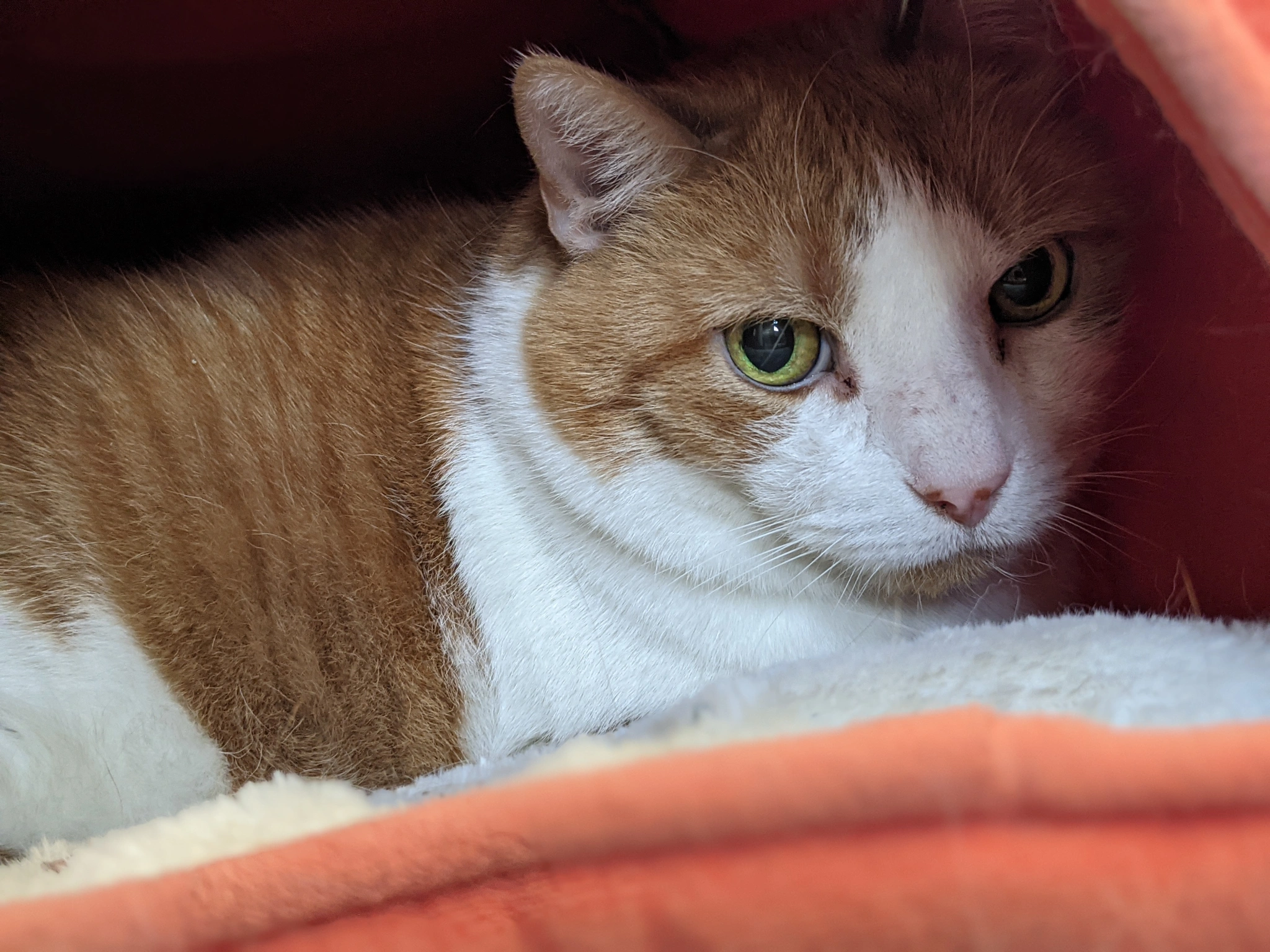
The next issue I want to bring up is behavior. Even in my own home, where my cats weren't obese, but only slightly overweight, I noticed behavior changes upon switching. They were far lazier on a dry diet - lounging around and resistant to play, experiencing "bursts" of energy then crashing. They'd also beg for human food relentlessly, and steal anything they could get their paws on. Bread bags left on the counter might be torn up in the morning, we had to put them in cabinets or on top of the fridge. Why? Just as we crave potato chips, cakes, cookies, we’ve turned our little carnivores into carb-crazy couch potatoes. They don’t even process them well, but those happy chemicals still do their job and they still make them fat and diabetic. I see these behaviors exemplify with cats on diets. When you place a cat on a calorie restricted dry diet, they're getting quick-burning carbs and often a lot of plant-sourced proteins, and they're hungry and rowdy a lot quicker than they would be with a tummy full of moist, animal protein-rich, low-carb food. Clients call me for trash can diving and pasta addicted cats - the story, they were recently placed on a limited calorie dry diet by the vet and they’re not happy about it. What do I tell these clients? Switch to wet. Higher moisture and protein content will make them fuller for longer. They may still be carb crazy for a little while, hide the pasta, but it will dissipate. When I took the dry food away in my own home, most of my cats transitioned without issue, but I had one cat in particular who protested hard. She loved wet food before the dry was gone, but once it was she refused to eat it at all. Instead, she was frenzied, stealing entire slices of pizza from our plates, diving into bowls of oatmeal, ripping open cake savers – it was absolutely insane. I tried every trick in the book to get her to eat wet food: raw meat, dry treats, squeeze treats, tuna – nope. I wasn’t bringing dry back in the house, I did regret just tossing it so I couldn’t mix it. Eventually I remembered that every time I had neonates all of my cats always went nuts wanting KMR. I pulled a can from a recent overnight litter out of the fridge and poured it over her wet. She devoured it and never complained again! Win! What also went away? No one bugs us for human food anymore. We can eat in peace. The pawing, biting, chaos is over. The universe makes sense again. They even vomit less, and their energy levels are a lot more balanced. They stay down longer after meals, but have plenty of energy during their waking hours and play the days away! They're all 10lbs and under. Doesn’t it seem like dry food creates something very unnatural, with all of that said? I will note that studies did state that dry-fed cats did actually seem to be more active – they presumed this was due to the faster metabolization due to higher carb and lower moisture, they were more likely to anticipate their meal and become antsy 2 or so hours before. Ultimately, they’re hungrier. Which, isn’t necessarily out of line with what I’ve said here, but I think overall activity is heightened with a healthy weight, wet fed cat…at least in my experience! That activity is also better controlled – they’re very calm after their feeding and remain calmer for longer, but their energy is much more efficient when ready to use, as it’s not just “sugar fuel,” it’s the good stuff. I eat less than 30g carbs and avoid added sugars in my own diet, and, I'll say that I feel it too! I have much more energy, and it's far more balanced. I don't crash as much. I am chronically ill - so I never feel great...but keto has helped me feel so much more "alive." It's not just cats! Think about that: We’re not cats or carnivores, and if a human can feel that much better cutting out sugars and carbs that we actually have the tools to process, what is it doing for our carnivorous friends who legitimately don’t have the tools to process these things? The less than 3% carbs a cat would eat in the wild, it’s presumed, would have already been through the digestive tract of the prey they’ve eaten (sitting in the bowels of the mice!) making it a much easier load for them. The 36% or so that we’re throwing at them in their Hill’s is just an absolute overload and completely unnecessary. Just saying.
What about dental health? Kibble cleans teeth, right? This one I must grant...a bit of leeway. There are genuine studies stating this so I cannot flat out say no, I haven’t done research to prove the contrary. I will say that this study states young cats fed dry had better teeth than old cats fed wet which...isn't exactly a 1:1 comparison. I'd like to see a more thorough version of the study files so that I may analyze it further to see statistical significance - and perhaps, who it was done by and if there is confirmation bias. This does still exist inpeer review - it is not a perfect process. It's just what we have, and the best we can come up with. Did Nestle do the study? Mars? Even some veterinarians disagee. I will be generous to both sides, but I believe one certainly makes more sense. Dental care is necessary no matter what diet you feed. A cat fed wet or dry will need a dental eventually, diet alone will not prevent or cause dental problems. We do not clean our teeth with food, we do not eat harder foods to clean our teeth – especially not cereal, the comparison I make for dry food. An argument can be made for the abrasion – there is more happening in there to break away plaque when eating something hard than there is when eating pate. However, starch and carb content play a role in creating more plaque and tartar and are more likely to hang around on the teeth. I’m stunned there isn’t more research into this. Personally, most cats I see eating dry do not chew enough to clean their teeth, they seem more prone to eat it whole – which is often proven by their vomit later, whole kibble in a swollen loaf on the floor. It swelled beyond their stomach’s capacity and caused them to vomit, they didn’t chew it. There’s a bunch of issues in that very statement, don’t you think? Lost their meal, aren’t chewing their meal, it is sticking to their teeth and turining to sugar, vomiting is a stressful event...think it's time for a change?
There’s so much more but this post isn’t about my vendetta against dry food. I just wanted to interject a few reasons why I find it important, why it may help your obese cat or help prevent obesity.
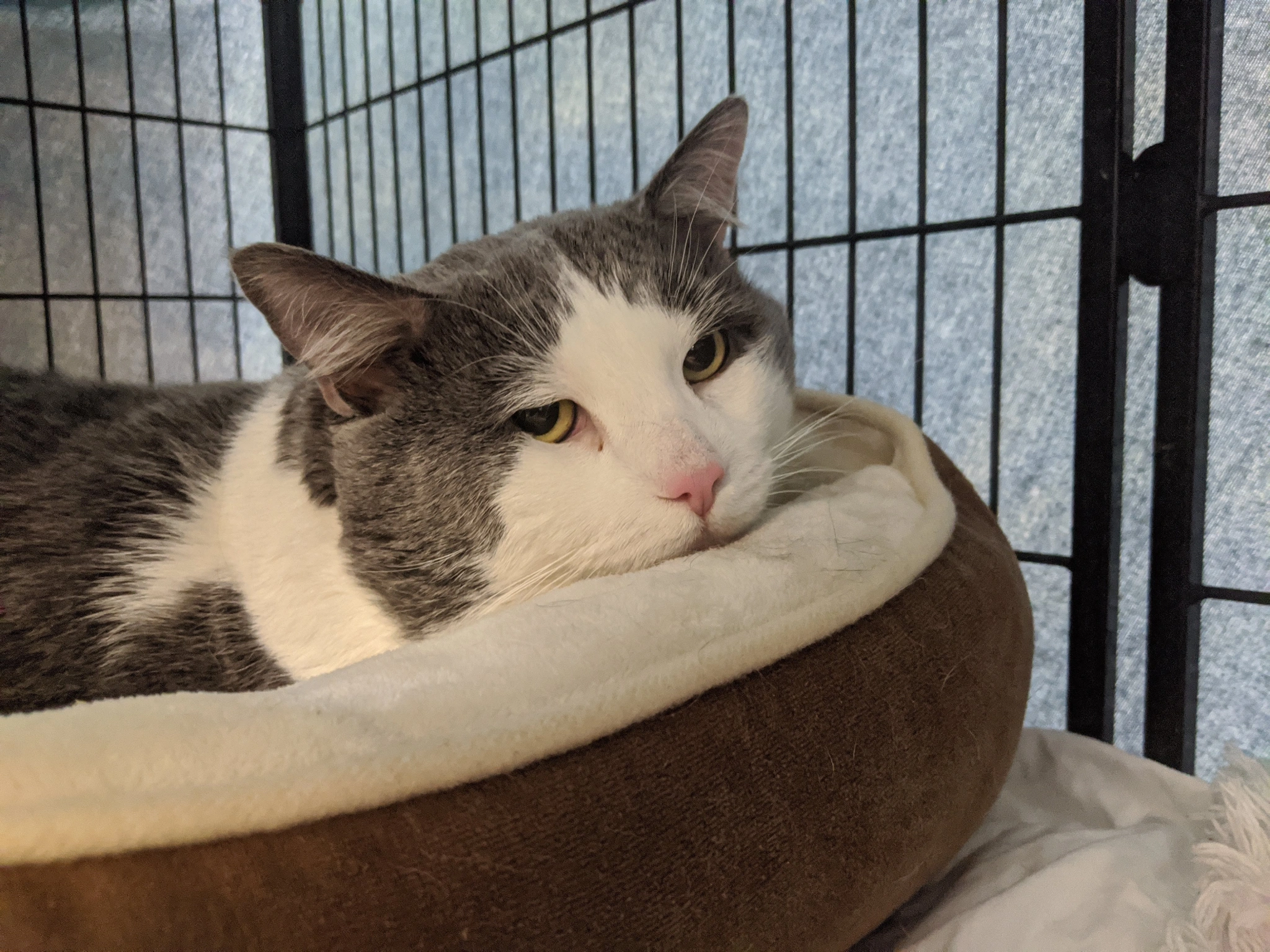
So, how might I recommend helping an already obese cat?
- 1. Figure out their calorie requirements and appropriately limit to a healthy defecit.
- 2. Find an appropriate wet food and switch over to that. You may need to mix wet and dry for a short period to adapt them to the change, but I firmly believe any cat can adapt. If you do not switch to wet, measure out your dry feedings precisely and make sure to have water readily available in multiple locations – see #4. Feed a higher quality dry containing meat proteins and better ingredients. I might recommend Instinct or Ziwi.
- 3. Schedule as many feedings as you can. Small feedings over time are better. I personally feed two times per day, but if you’re able to feed three or four times, your cat would greatly appreciate it. This is splitting that caloric requirement throughout those feedings, do not add extra! You can not feed your cat once daily.
- 4. Pick up a water fountain. This isn’t necessarily related to weight loss, but hydration is important and fountains are best!
- 5. Pick up the bowls as soon as the cat walks away, dispose of any uneaten portions.
- 6. Exercise! If your cat will not play, are they food motivated? Will they work for some smelly fresh tuna or cooked chicken? Will they eat freeze-dried raw treats? These are great low or zero-carb, low-calorie options to get them moving. Lure them across the room, reward them for following the toy, reward them for following you or the food itself. Throw the food across the room and they’ll automatically be rewarded for getting it. Whatever. Just get them moving. You can subtract the calories from their diet, or if it’s minimal enough, let it go to start; you should have to use fewer treats as time goes on.
- 7. If they’re in really bad shape, picking up a walkabout harness to take some weight off of their joints may be helpful for these exercises. These allow you to lift the cat a bit but still allow them freedom of movement, reducing impact, kind of like hydrotherapy!
- 8. If you have time and can afford it, hydrotherapy! If your cat isn’t mortified of water and you feel safe attempting it in your own home, you can set up faux-hydrotherapy in your own tub or a kiddie pool, just get them to walk laps in some nice warm water. The real deal is obviously better, but anything is helpful.
- 9. Acupuncture. It helps!
- 10. Dasquin and/or Cosequin – Support those joints!
- 11. Stay consistent. As time goes on, introduce new activities and adjust their caloric input. Weigh every 14 days. Keep going. Eventually, your cat may be playing fetch, chasing the wand toy, eating normal meals, being a spry, lively cat again. It’s possible.
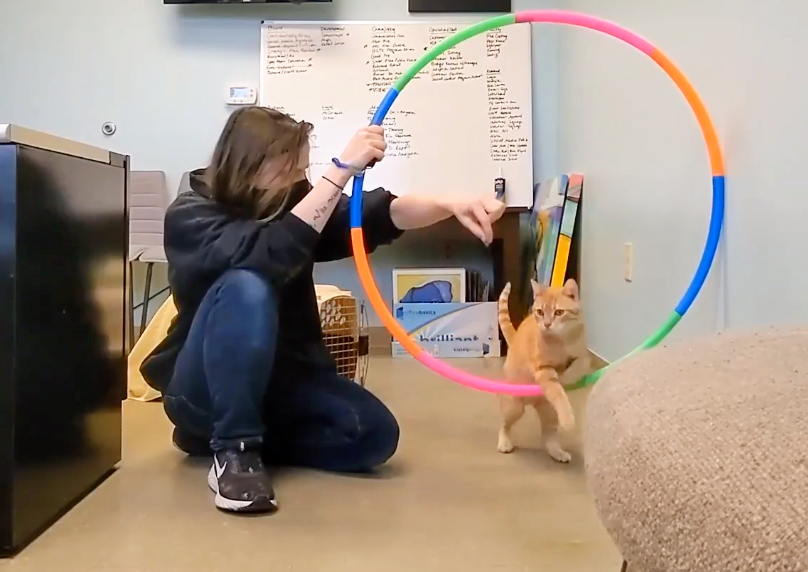
An activity you might consider to shed some pounds. Betty was great at jumping through the hoop for treats!
How do I propose we prevent obese cats?
- 1. Start them out on the best diet possible, whatever that is for you. I recommend canned or complete raw in a variety of rotating proteins, but if that’s not possible for you, the best and lowest carb dry you can (and please, throw some wet in there too!) I love novel proteins – rabbit is a favorite for my kiddos, but it’s not meant for every day feeding. Chicken is a go-to, but it can be highly inflammatory and often a source of allergic reactions. I avoid fish for anything more than an occasional treat. Experiment, try a variety, but make sure everything you're feeding is complete.
- 2. Never free feed. Always feed on a schedule and pick those bowls up if they don’t finish their meals, keep the bowls clean. (Especially if you raw feed! Sanitation is important!) As many feedings as you can reliably manage, at minimum two. If you have a kitten, it will need to be more than that, however (Under 4 mos I recommend 4)
- 3. Maintain regular daily exercise.
- 4. If you notice changes, explore them. If they’re putting on weight without a reason to, get them to the vet. There could be something bigger going on and you don’t want to just let it go.
- 5. Manage stress. Keep enrichment high and if they’re experiencing stress or anxiety for any reason, don’t just let it go or assume it will sort itself out – start looking for solutions, problem solve, find sites like this one, call a local shelter, vet, or behavior professional for assistance.
It should, in theory, be that simple. Bond with your cat through activity, not food. Or, still do...I love feeding my cats! I just don't ever have the desire to overdo it. I don’t know why us humans develop this “More more more” mentality, but we often do.
Chonky is not synonymous with "spoiled." Fat cats do not signify a great quality of life. It’s not fat and happy, it’s fat and struggling. Please keep your cats healthy. A healthy cat is just as cute and sweet as a chubby one, I promise. Garfield was a bad example. Spoil your cat with a new cat tree, not a bigger meal! It could gain you extra years, fewer vet bills. It’ll be worth it.
Until next time.
-Meg
